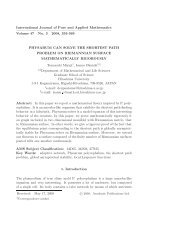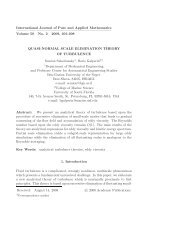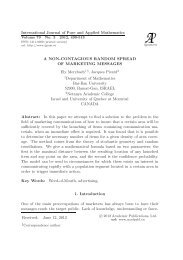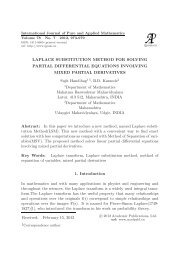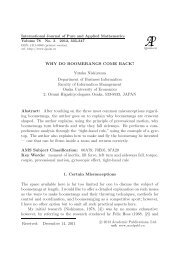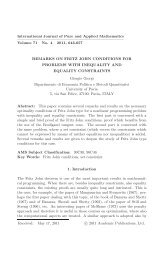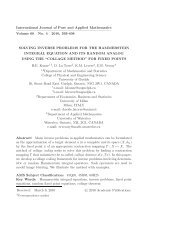BIRKHOFF INTERPOLATION OVER A FINITE FIELD
BIRKHOFF INTERPOLATION OVER A FINITE FIELD
BIRKHOFF INTERPOLATION OVER A FINITE FIELD
You also want an ePaper? Increase the reach of your titles
YUMPU automatically turns print PDFs into web optimized ePapers that Google loves.
International Journal of Pure and Applied Mathematics<br />
————————————————————————–<br />
Volume 39 No. 2 2007, 147-149<br />
<strong>BIRKHOFF</strong> <strong>INTERPOLATION</strong> <strong>OVER</strong> A <strong>FINITE</strong> <strong>FIELD</strong><br />
E. Ballico<br />
Department of Mathematics<br />
University of Trento<br />
380 50 Povo (Trento) - Via Sommarive, 14, ITALY<br />
e-mail: ballico@science.unitn.it<br />
Abstract: Fix integers n ≥ m − 1 ≥ 0, a Birkhoff interpolation problem B<br />
(interpolation of a polynomial and certain of its derivatives of order ≤ n at<br />
m points of a field) induced by a matrix E = [ei,k], 1 ≤ i ≤ m, 0 ≤ k ≤ n,<br />
ei,k ∈ {0,1}, a prime p > n and a p-power q. Here we prove the regularity of B<br />
at (t1,...,tm) ∈ Fm q if it is regular at (t q/p<br />
1 ,...,t q/p<br />
1 ) ∈ Fm p . The regularity over<br />
Fp was recently studied by T. Tassa to solve a cryptographic model (hierarchical<br />
thresold secret sharing).<br />
AMS Subject Classification: 14N05<br />
Key Words: Hermite interpolation, Birkhoff interpolation, finite field<br />
*<br />
Fix integers n ≥ m − 1 ≥ 0. An interpolation matrix for a Birkhoff problem<br />
with parameters (n,m) is a matrix E = [ei,k], 1 ≤ i ≤ m, 0 ≤ k ≤ n, such<br />
that ei,k ∈ {0,1} for all i,k and E has exactly n + 1 non-zero entries (see [1],<br />
Chapter IV, Section 9, 10, or [4]). Fix a field K such that either char(K) = 0<br />
or char(K) > n. For the case 0 < char(K) ≤ n, see Remark 1. The matrix E<br />
is the abstract datum for the following classical interpolation problem due to<br />
Birkhoff. Fix t1,... ,tm ∈ K such that ti �= tj for all i �= j. Let VK[E;t1,... ,tm]<br />
denote the K-vector space of all polynomials f in one variable over K such that<br />
f (k) (ti) = 0 for all i,k such that 0 ≤ i ≤ n, 1 ≤ k ≤ m and ei,k = 1; here f (k)<br />
denotes the order k derivative of f. The Birkhoff problem associated to E is<br />
regular at t1,...,tm if V [E;t1,... ,tm] = {0}. The Birkhoff problem associated<br />
Received: March 19, 2007 c○ 2007, Academic Publications Ltd.
148 E. Ballico<br />
to E is called regular if it is regular at all m-ples of distinct elements of K.<br />
The condition that E has exactly n + 1 non-zero entries is equivalent to the<br />
hope of existence and uniqueness of the solutions. In the homogeneous case, the<br />
good behaviour of the interpolation problem means that the zero-solution is the<br />
only solution. The notion of regularity strongly depend from the choice of K<br />
(for an R-regular, but not C-regular problem, see [1], Example (c) at p. 125).<br />
Indeed, very few Birkhoff matrices are regular in this sense over an algebraically<br />
closed field. Our interest is the case K finite and we want to study existence<br />
of good m-ples for as much Birkhoff matrices as possible. Our interest comes<br />
from cryptography and it was aroused from [5]. T. Tassa used a very particular<br />
Birkhoff matrix E to make a model for the problem of threshold secret sharing.<br />
Fix n ≥ m−1 ≥ 0 and a Birhkoff matrix E with parameters (n,m) and assume<br />
p > n. He assumed p ≫ 0 but we want to use also lower p. Take a p-power q,<br />
say q = p e with e ≥ 1. He used in [5] only the case q = p, but we want to be<br />
allowed to increase arbitrarly the size of the field, just increasing the integer e.<br />
Theorem 1. Fix a Birkhoff matrix E of type (n,m), a prime p > n, a<br />
p-power q = pe , e ≥ 2, and t1,... ,tm ∈ Fq such that t q/p<br />
i �= t q/p<br />
j for all i �= j<br />
and that E is regular at the m-ple (t q/p<br />
1 ,... ,t q/p<br />
m ) ∈ Fm p (as a Birkhoff problem<br />
over Fp). Then E is regular at (t1,... ,tm) (as a Birkhoff problem over Fq).<br />
Obviously, Theorem 1 has the following corollary.<br />
Corollary 1. Fix integers n ≥ m − 1, a prime p > n, a p-power q and<br />
t1,...,tm ∈ Fq such that t q/p<br />
i �= t q/p<br />
j for all i �= j. Let E be a Birkhoff matrix<br />
of type (n,m) which is regular for Fp. Then E is regular at (t1,... ,tm) for the<br />
field Fq.<br />
Notice that the assumption on the m-ple (t1,...tm) ∈ Fm q does not depend<br />
from the choice of E, but only from its regularity over Fp. Hence we may fix<br />
(t1,... tm) before knowing E and for many different matrices E.<br />
Proof of Theorem 1. Fix f = �n j=0 ajxk ∈ VFq[E;t1,...,tm]. Hence the<br />
n + 1 coefficients aj ∈ Fq satisfy the following n + 1 linear equations:<br />
�<br />
j≥k<br />
(j!/k!)ajt j−k<br />
i = 0, ei,k = 1. (1)<br />
Now we raise to the q/p power the left hand side of each of the equations (1),<br />
obtaining the following linear system:<br />
�<br />
(j!/k!)<br />
j≥k<br />
q/p a q/p<br />
j (t q/p<br />
i ) j−k = 0, ei,k = 1. (2)
<strong>BIRKHOFF</strong> <strong>INTERPOLATION</strong> <strong>OVER</strong> A <strong>FINITE</strong> <strong>FIELD</strong> 149<br />
Notice that (j!/k!) q/p ≡ j!/k! (mod p) and hence (j!/k!) q/p = j!/k! as elements<br />
of Fp. Since a q/p<br />
j ∈ Fp for all j and VFp[E;t q/p<br />
1 ,...,t q/p<br />
m ] = {0}, we obtain<br />
a q/p<br />
j = 0 for all j, i.e. aj = 0 for all j, concluding the proof.<br />
Remark 1. Assume p := char(K) > 0. The order p derivatives of the<br />
polynomial t p is identically zero. Hence if p ≤ n, we must modify the set-up of<br />
the problem. We use the Hasse derivatives instead of the ordinary derivatives<br />
(see [2], §3, for their definition and main properties). With the use of Hasse<br />
derivatives the geometry of a rational normal curve of P n and the approach of<br />
[3] show that any Hermite problem (i.e. any Birkhoff problem with a matrix E<br />
such that ei,k = 1 implies ei,h = 1 for all 0 ≤ h ≤ k) is regular over any field K<br />
without any restriction on char(K). However, it seems very likely to us that if<br />
p ≤ n too many interesting Birkhoff problems are not regular.<br />
Acknowledgements<br />
The author was partially supported by MIUR and GNSAGA of INdAM (Italy).<br />
References<br />
[1] R.A. DeVore, G.G. Lorentz, Constructive Approximation, Grundlehren der<br />
Mathematischen Wissenshaften 303, Springer-Verlag, Berlin (1993).<br />
[2] A. Hefez, Nonreflexive curves, Compositio Math., 69, No. 1 (1989), 3-35.<br />
[3] D. Laksov, Wronskians and Plücker formulas for linear systems on curves,<br />
Ann. Scient. École Norm. Sup., 17 (1984), 565-579.<br />
[4] G.G. Lorentz, K. Jetter, S.D. Riemenschneider, Birkhoff interpolation,<br />
Encyclopedia of Mathematics and its Applications, Volume 19, Addison-<br />
Wesley, Reading (1983).<br />
[5] T. Tassa, Hierarchical threshold secret sharing, In: The Proceedings of the<br />
First Theory of Cryptography Conference, TCC 2004, MIT, Cambridge<br />
(February 2004), 473-490.
150



